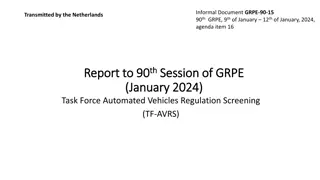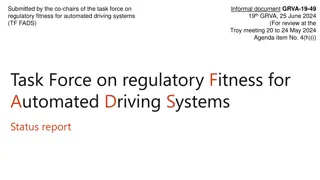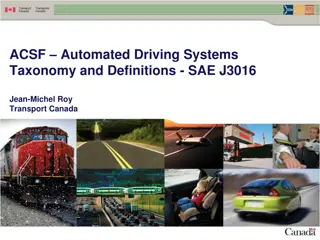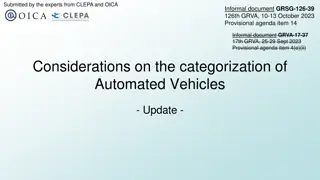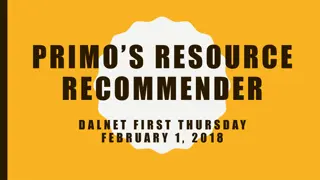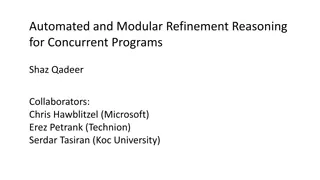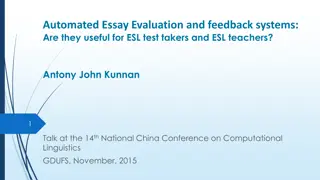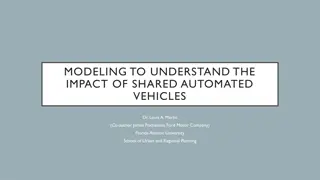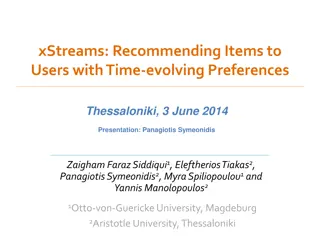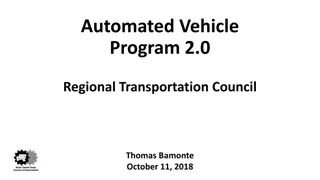Understanding Recommender Systems: A Primer on Automated Recommendations
Recommender Systems play a pivotal role in today's digital landscape, offering personalized content recommendations to users across various platforms like Netflix, Spotify, and Amazon. The roots of modern Recommender Systems can be traced back to the 1990s with concepts such as collaborative filtering and deep learning driving advancements in the field. This primer explores the history, success stories, and significance of Recommender Systems in the realm of machine learning and user engagement.
- Recommender Systems
- Automated Recommendations
- Machine Learning
- Personalized Content
- Collaborative Filtering
Download Presentation

Please find below an Image/Link to download the presentation.
The content on the website is provided AS IS for your information and personal use only. It may not be sold, licensed, or shared on other websites without obtaining consent from the author. Download presentation by click this link. If you encounter any issues during the download, it is possible that the publisher has removed the file from their server.
E N D
Presentation Transcript
Recommender Systems A Primer Pablo Castells pablo.castells@uam.es Dietmar Jannach dietmar.jannach@aau.at
Recommender Systems A Primer Accompanying slides for Castells, P., Jannach D., Recommender Systems: A Primer, in: Alonso, O. and Baeza-Yates, R. (eds.): Advanced Topics in Information Retrieval, ACM, 2024 Preprint available at: https://arxiv.org/abs/2302.02579
Recommender Systems Automated recommendations are omnipresent Netflix, Spotify, Amazon, LinkedIn, Instagram, Facebook, Twitter, TikTok Recommender Systems (RS) Systems that determine the most suitable content to present to users Based on statistics and machine learning Recommendations often made in a personalized way
Recommender Systems A very visible success story of machine learning e.g., TikTok, which is mainly a recommender system RS create value for various stakeholders Businesses and consumers A highly dynamic and active field of research high demand in industry fueled by constant progress in machine learning
History Roots and relationships with Information Retrieval (IR) Main IR success example: Search engines (Google) IR mostly based on search queries RS learn interests from user behavior instead Roots of modern RS in 1990s: Tapestry A personalized email filtering system (1992) Introduces the idea of collaborative filtering Rely on opinions of others when filtering Show me content that John liked
History Roots of modern RS in 1990s: GroupLens Automated the idea of collaborative filtering (1994) Based on the identification of like-minded users (neighbors), based on their past ratings Predict rating for new content based on neighbor opinions Recommendation as matrix filling/completion Matrix filling as a predominant research operationalization Today: Mostly based on deep learning
GroupLens Rating interface and rating matrix Goal is to predict the empty cell values
History Roots of modern RS: content-based filtering Filter and rank items based on their content (e.g., the actual news message) Ranking based on similarity of content to the content the individual user liked in the past Based on IR methods e.g., document encoding/representation, similarity functions Hybrids Combine different approaches e.g., collaborative filtering with side information
History First industry success in late 1990s e.g., in e-commerce and music Amazon as an early adopter provide recommendations at scale Today: Wide-spread use of recommendations in industry A highly active academic research field Own conference series and journal on recommenders Still many open challenges and opportunities
The Recommendation Task Main task is to determine which items to show to a user in a given situation Central questions, depending on application What criteria to use for filtering and ranking? The chosen criteria depend on the following What is the purpose of the system? How should it create utility or value for different stakeholders?
The Value Perspective Various forms of value possible Both for consumers and providers Possible consumer value: Reduce information overload, help people find relevant content Possible provider value: Improve Key Performance Indicators, e.g., sales volume or customer retention Academic research commonly abstracts from such specifics Driven by interest in designing application-independent solutions
Abstract Problem Characterization An abstract computational task: Compute an estimate of the absolute or relative relevance of individual items for a given user A common formalization: Given a set of users U, a set of items I, a utility function (which maps users and items to a utility value) Recommend the item(s) with the highest utility
Abstract Problem Characterization Given this characterization: Algorithmic research in RS aims to define or learn the utility function f The utility function f can be based on various types of information Learning f in collaborative filtering systems Nearest-neighbor approach in early systems All sorts of machine learning approaches were applied to learn f from the noisy data in the user-item matrix Today: deep learning
The User-item Rating Matrix Since the early GroupLens system Operationalized goal Predict the values in the empty places in the matrix Many types of models can be applied Leveraging additional data Various sorts of side information may be incorporated
Explicit and Implicit Feedback From GroupLens (1994) to the Netflix Prize (2006-2009): Matrix is assumed to be filled with explicit user ratings, e.g., from one to five stars Today: Mostly implicit feedback is assumed to exist E.g., a purchase is considered a positive rating in e-commerce This feedback is also mostly positive Requires interpretation and can be noisy Not having purchased item may not be a negative signal
Adding Context Any sort of information can be added to f Context is a popular factor in the literature Context describes the current situation of the user geographical position, time, weather, social environment Utility (e.g. of a given restaurant) may largely depend on the context Leads to extended utility function
From Rating Prediction to Ranking Individual rating prediction not too relevant in practice Instead, ranking the items is the focus today Leading to the top-N recommendation task Ranking can be achieved: by sorting individual ranking predictions through learning-to-rank algorithms Leading to a list optimization problem where L* is the set of all item permutations up to size N
Item and List Utilities What is the utility, we seek to optimize? In GroupLens: Utility = Rating Recommend items with highest predicted rating In reality, we could also consider provider utility Item utility vs. list utility Historically, item-wise utility assessment was the focus This, however cannot capture quality aspects that relate to the entire list e.g., the overall diversity of the list
Recommendation Algorithms Recommendation as a supervised machine learning problem Given examples of observed user choices Learn parameters of a utility function f which minimizes a cost function Cost function could be the squared prediction error; or a binary cross-entropy loss to quantify the ranking error Predict present or future user interests Distinguishing algorithms (i) by form of the utility function (parameterized model), (ii) cost function, (iii) optimization approach
Recommendation Algorithms An example utility function Dot product (similarity) between user- and item embeddings Where embeddings are low-dimensional representations of objects in the form of vectors of real-valued numbers, and where the embeddings are parameters of the model to be learned The model is a choice from a family of functions (the hypothesis space) Model parameters are learned based on training by minimizing the cost function Additional hyperparameters may have to be tuned
Categorization by Type of Input A particularity of the learning problem There is a human factor at the core Vagueness and noise in user behavior and preferences It is also not only about predicting preferences, but also to enhance/change user actions Not objectively clear what s a good recommendation Difference to other applications of machine learning where some ground truth is known e.g., categorization of images, extraction of keywords or named entities from text
Categorization by Type of Input Collaborative filtering: Based solely on logged user-item interactions, among the most powerful approaches Based on abstract principle that people can benefit from the experience and discoveries of other people Achilles heel: Problems when the interaction matrix is sparse (cold-start situation) Using side information: Incorporate different types of information, in particular in sparse regions of the matrix
Categorization by Type of Input Content-based filtering: Rely solely on information about items, and the past preferences of the individual ( target ) user Relevant item features are termed content for historical reasons Hybrid systems (in terms of inputs): Various other types of external information can be incorporated Social interactions between users, user demographics, context information (time, weather, user device, )
Collaborative Filtering Algorithms Nearest-Neighbors Inspired by word-of-mouth behavior, where people take advice from trusted friends k-nearest-neighbor (kNN) approaches make predictions based on the weighted average of the advice by similar other users (neighbors/peers) Recommendation viewed as a regression problem predicted level of preference for user u based on linear combination of preferences of selected other users N[u]
Collaborative Filtering Algorithms Nearest-Neighbors Utility function as weighted sum Cias a normalization term e.g., cosine similarity, Pearson similarity indicates that a neighbor rating exits is a similarity function between users
Collaborative Filtering Algorithms Nearest-Neighbors Normalization term, e.g., to scale prediction to rating scale k, the number of neighbors, is a hyperparameter Variations of the kNN scheme Item-based kNN: Swap roles of users and items Neighborhood selection, similarity functions
Collaborative Filtering Algorithms Nearest-Neighbors in sum Old idea, conceptually simple Na ve implementation may not too scalable, but can be engineered Still a competitive approach today in some applications Should be considered as a baseline in algorithm comparisons
Collaborative Filtering Algorithms Matrix factorization Assumes that interests of users can be described in a low-dimensional space of latent factors Users and items are described as vectors in a common latent factor vector space Similar users have similar vectors; same for items Such vectors (e.g., of size 64) are called embeddings Latent factors have no direct real-world correspondence, e.g., with item properties, and are not interpretable. They are dimensions in a multi-dimensional space Number of factors is a hyperparameter to determine
Collaborative Filtering Algorithms Matrix factorization In a k-dimensional space, users and items are represented as vectors p and q: Coordinates dimension z, and how much factor z is present in I Assumption: Interest of user u in item i can be captured by the dot product of the latent vectors express the interest of user u in
Collaborative Filtering Algorithms Matrix factorization (MF) Producing the latent factors done by minimizing of a cost function R (risk/expected loss), which involves the error in predicting the training data Squared error Regularization term || .|| is the L2-norm for regularization, to avoid overfitting; is a hyperparameter
Collaborative Filtering Algorithms Matrix factorization Optimization done, e.g., by stochastic gradient descent Ranking of items based on the dot product of user and item vectors Many variations and extensions proposed, e.g., bias terms for users and items temporal factors
Collaborative Filtering Algorithms Learning to Rank (LTR) Item ranking found to be more important than point predictions Introduction of a loss/cost function that involves item ordering (rather than rating prediction error) The cost function represents the amount of contradiction between predicted/learned ranking and the training data Mostly following a pairwise approach, error defined as number of incorrectly ranked pairs
Collaborative Filtering Algorithms Learning to Rank (LTR) Pairwise loss function are the parameters of the recommendation model quantifies the contradiction and involves the utility Summed over all pairs of items where training data exists Bayesian Personalized Ranking (BPR) as a common example Based on the probability that the scores by the model are in contradiction to the training data
Collaborative Filtering Algorithms Bayesian Personalized Ranking Probability of ranking precedence is smoothed as a logistic sigmoid of the ranking score difference Assume a MF model, with Optimization via gradient descent Can be seen as layer on top of MF
Collaborative Filtering Algorithms Neural recommendation, deep learning (DL) MF: uses dot product as linear utility scoring function Not designed to capture complex, non-linear relationships Deep learning (neural) techniques very successful in many application areas of machine learning Promise also in recommender systems Ability to approximate any prediction function Easy to integrate various types of data Less need for feature engineering Availability of software libraries
Collaborative Filtering Algorithms Neural recommendation Rapid adoption of DL for recommendation around 2015 Nowadays considered the state-of-the-art approach, both in academia and industry All sorts of network architectures explored, e.g., multi-layer perceptron, autoencoder, convolutions, recurrent neural networks, transformer, Progress paradox Certain hype led to rushed evaluations using untuned baselines in the beginning Actual progress not always clear
Collaborative Filtering Algorithms Neural recommendation Often best choice when large amounts of data and side information are available May also help reduce feature engineering efforts DL approaches can however also be challenging for different reasons Computational complexity Extensive hyperparameter search, or even architecture search needed Black-box nature of the models (limited interpretability and explainability) Nonetheless a thriving area
Content-based and Hybrid Recommenders Collaborative Filtering, as discussed, can be highly effective without requiring information about the items themselves However, often such information is available It may make sense to consider this information Assume that we know the preferred movie genres of the user It is only intuitive to recommend more of that genre In particular when there is little interaction information for the user or the item available (user cold-start, item cold-start)
Content-based and Hybrid Recommenders Pure Content-based Systems Consider preferences on a user-individual basis Formal characterization predicted user-item relevance f based on a scoring function, which matches the content-based preference profile of user u with the content features of item i
Content-based and Hybrid Recommenders Pure Content-based Systems Can be implemented in various ways Assuming that textual descriptions of the items are available Traditionally, these documents are TF-IDF (Term-Frequency Inverse Document Frequency) encoded The function Content(i) would thus return a real-valued vector of importance values for the terms in the document TF-IDF value is the multiplication of TF and IDF TF indicates how often a term appears in a document, normalized for document length IDF indicates how informative the term is in a given document collection. Terms that appear everywhere carry little information
Content-based and Hybrid Recommenders Pure Content-based Systems How to implement ContentBasedProfile(u)? Could encode all liked documents of a user via TF-IDF User profile could then be the average of the vectors The score function to match items with the user s past profile could then be the dot product Various implementation variants possible Today, documents are often represented as semantic embeddings (distributed representations) Various types of exogenous information, e.g., from Wikipedia can be integrated
Content-based and Hybrid Recommenders Pure Content-based Systems Specific application use cases, e.g., When constantly new items appear (e.g., in the news domains), for which not sufficient information is available When the general user preferences are rather stable over time When providing similar item recommendations Certain limitations By design recommend more of the same , leading to limited discovery May also surface content that is too niche
Content-based and Hybrid Recommenders Hybrid recommender systems Rely on more than one paradigm (type of inputs) Combine advantages of individual methods while avoiding their shortcomings Trivial example for content-based recommendation Remove all items that received a too low overall community rating
Content-based and Hybrid Recommenders Hybrid recommender systems Three main categories of hybrids Monolithic: Different strategies are implemented in one algorithm, e.g., a model that considers both collaborative and content information Parallelized: The outcomes of two or more algorithms are first computed independently and then combined, e.g., weighted. Switching strategies also fall into this category Pipelined: The output of one algorithm serves as an input to the next, e.g., one could first filter candidates by popularity and subsequently rank the remaining ones
Content-based and Hybrid Recommenders CF with side information The most common hybrid approach Side information not limited to item-related information
Content-based and Hybrid Recommenders CF with side information User data: Static or slowly changing, e.g., demographics such as age gender, nationality; also: personality traits Item data: Dependent on application, can be pre-structured like categories, or unstructured such as descriptions, reviews or images Context data: Various types of frequently changing context information, e.g., geographic position, time of the day, weather, end user device
Content-based and Hybrid Recommenders CF with side information Interaction data: Historically: Focus on ratings, nowadays various types of implicit feedback, e.g., item views, purchases, add-to-cart, search actions, later item returns; often including time stamps Exogenous data: Inclusion of world knowledge , e.g., form Wikipedia or through Linked Open Data. User-individual exogenous data include the user s social network or trust relationships Recent focus on information-rich collaborative filtering Many opportunities for (graph-based) neural network approaches
Discussion of Algorithms Only discussed selected algorithms other notable ones include Factorization Machines, Sparse Linear Models (SLIM) and EASERbased on a shallow auto encoder recent developments focus more on sequential recommendation problems Generally, we recall that algorithms are just one component of a recommender system albeit the most researched one in the literature
Evaluation of Recommender Systems A large variety of algorithms exist An informed choice requires reliable evaluation methodologies Generally, evaluation involves a comparison of two or more systems or system variants In industry: Online A/B (field) tests Run two systems in parallel and compare effects after testing period In academia (and industry): Offline evaluation Based on historical data Cheap to explore various algorithms and configurations
Online Evaluation A standard approach in industry Yet, A/B tests can be costly and risky Offline evaluation often done in advance, before A/B testing e.g., to filter variants that are assumed to be low-performing online Procedure Two systems, A and B, are compared online; sometimes more than two Each system receives some fraction of the traffic A is often called control (e.g., the existing system), B the treatment Users are randomly assigned to one group, and participants are not aware of being in a group







